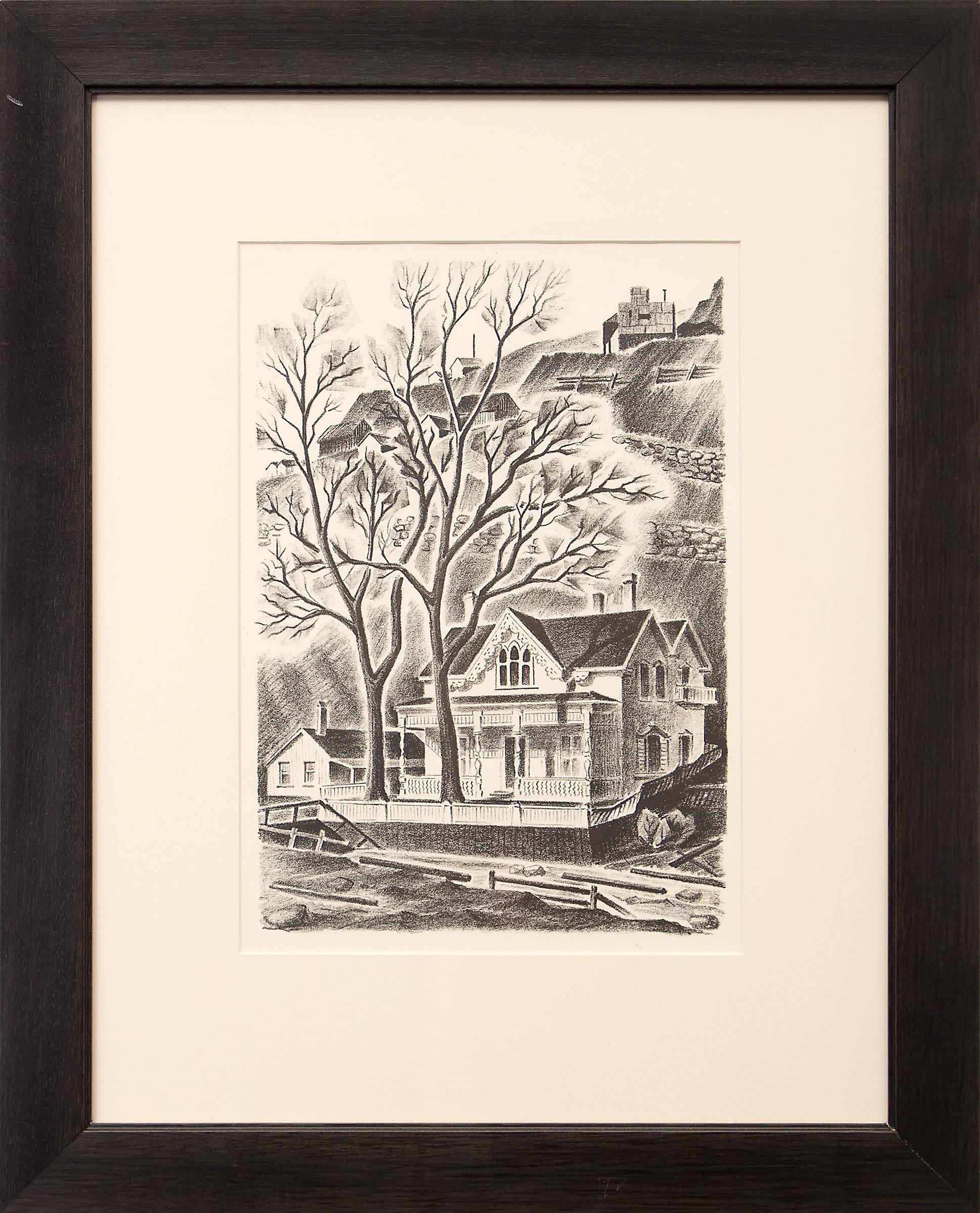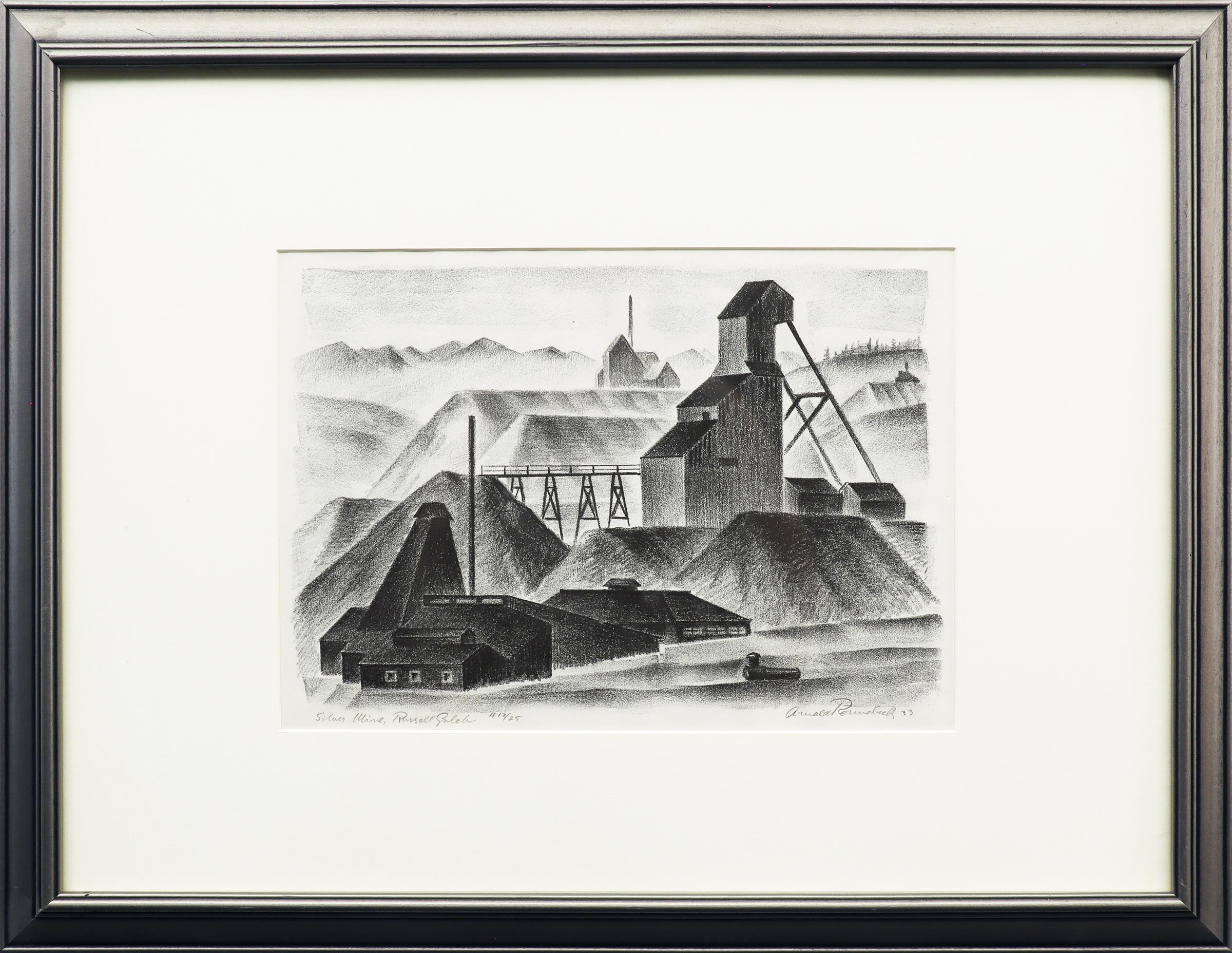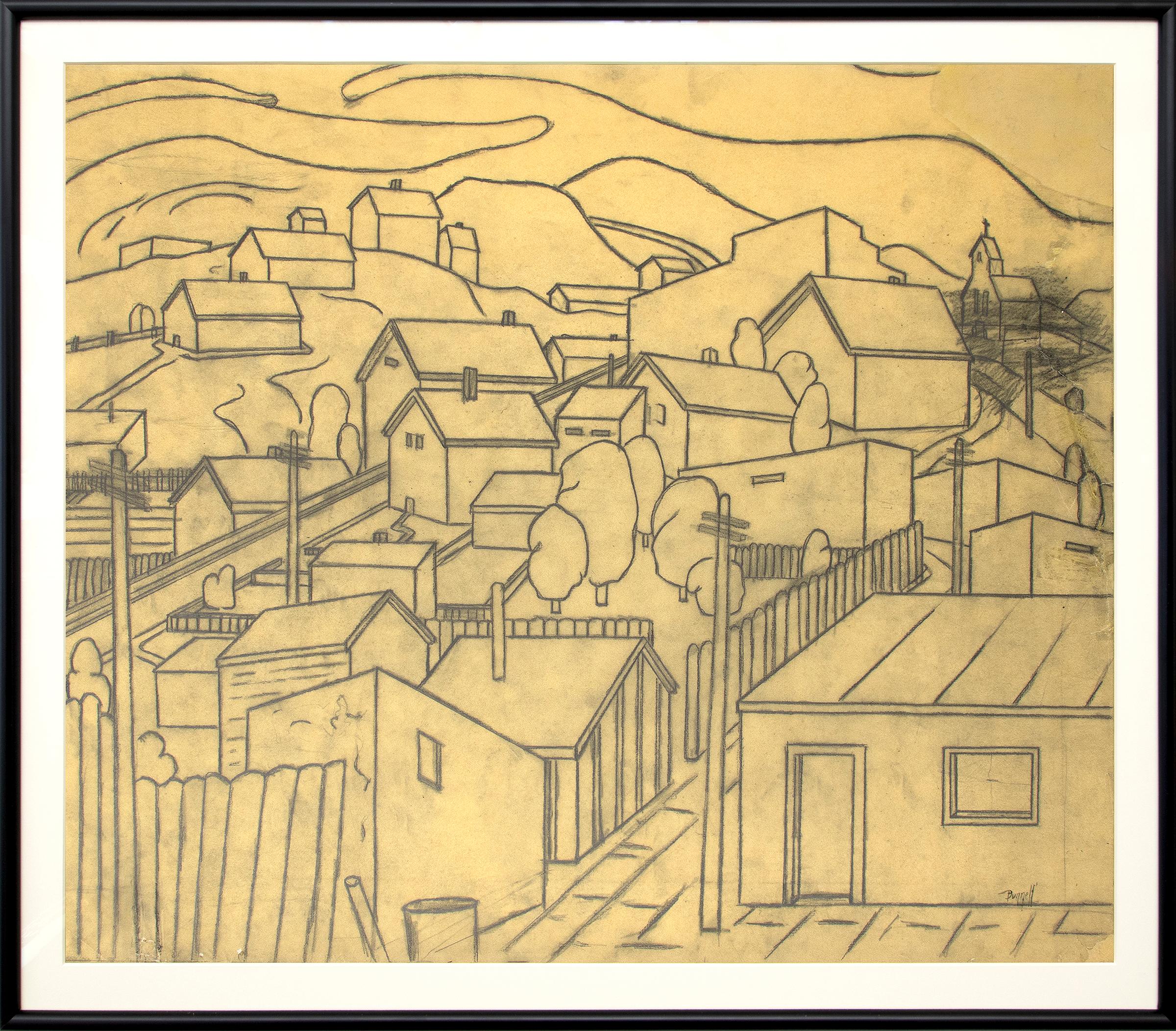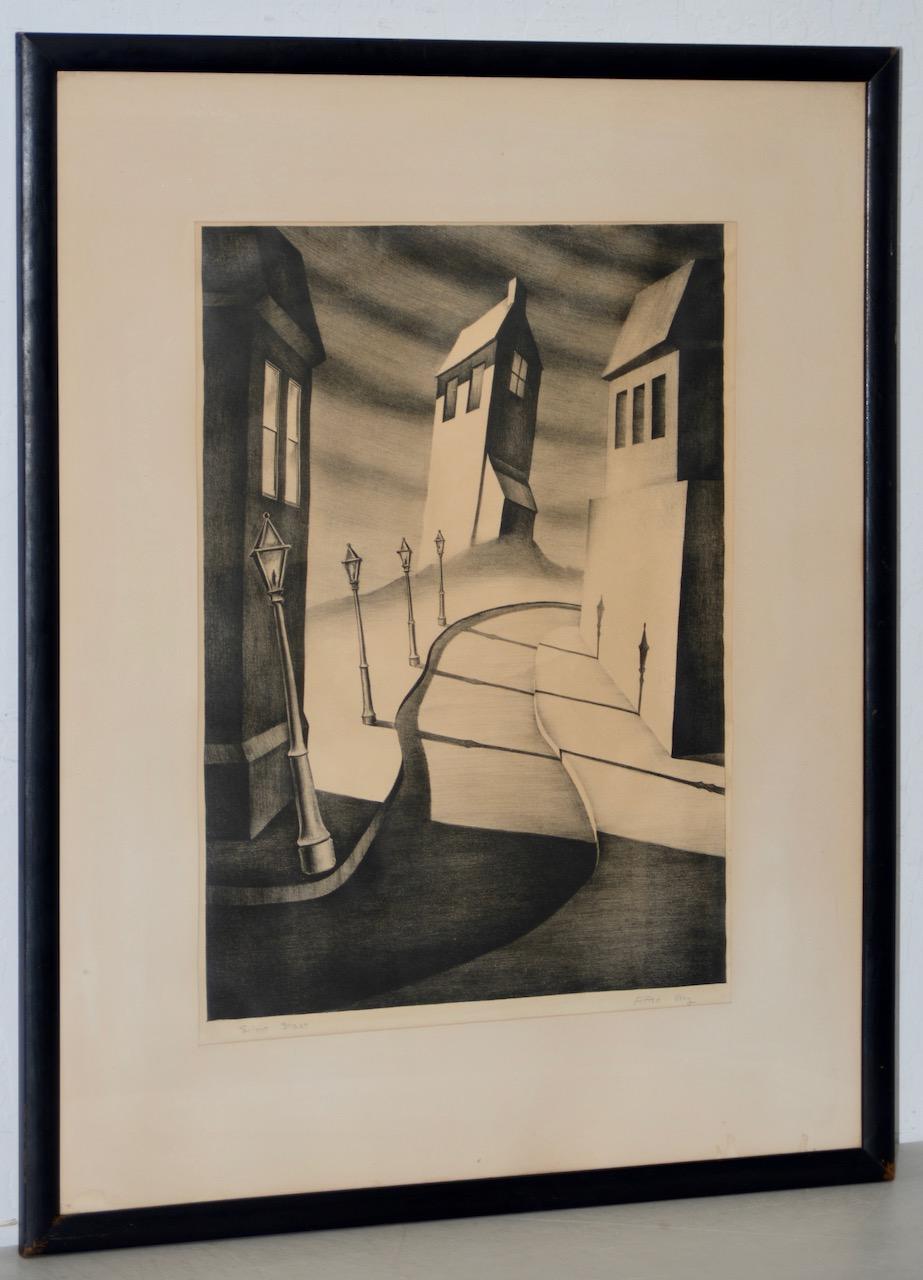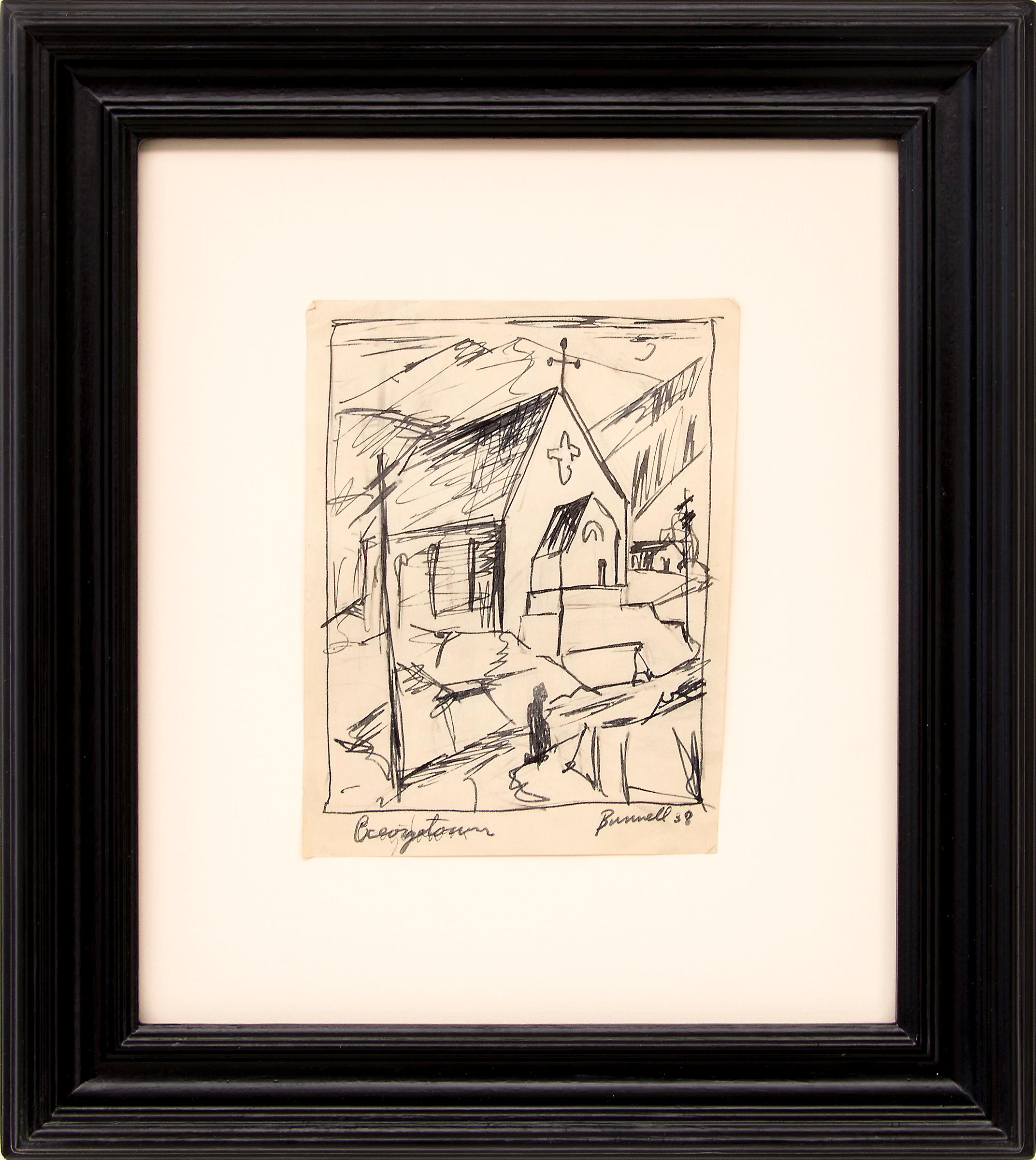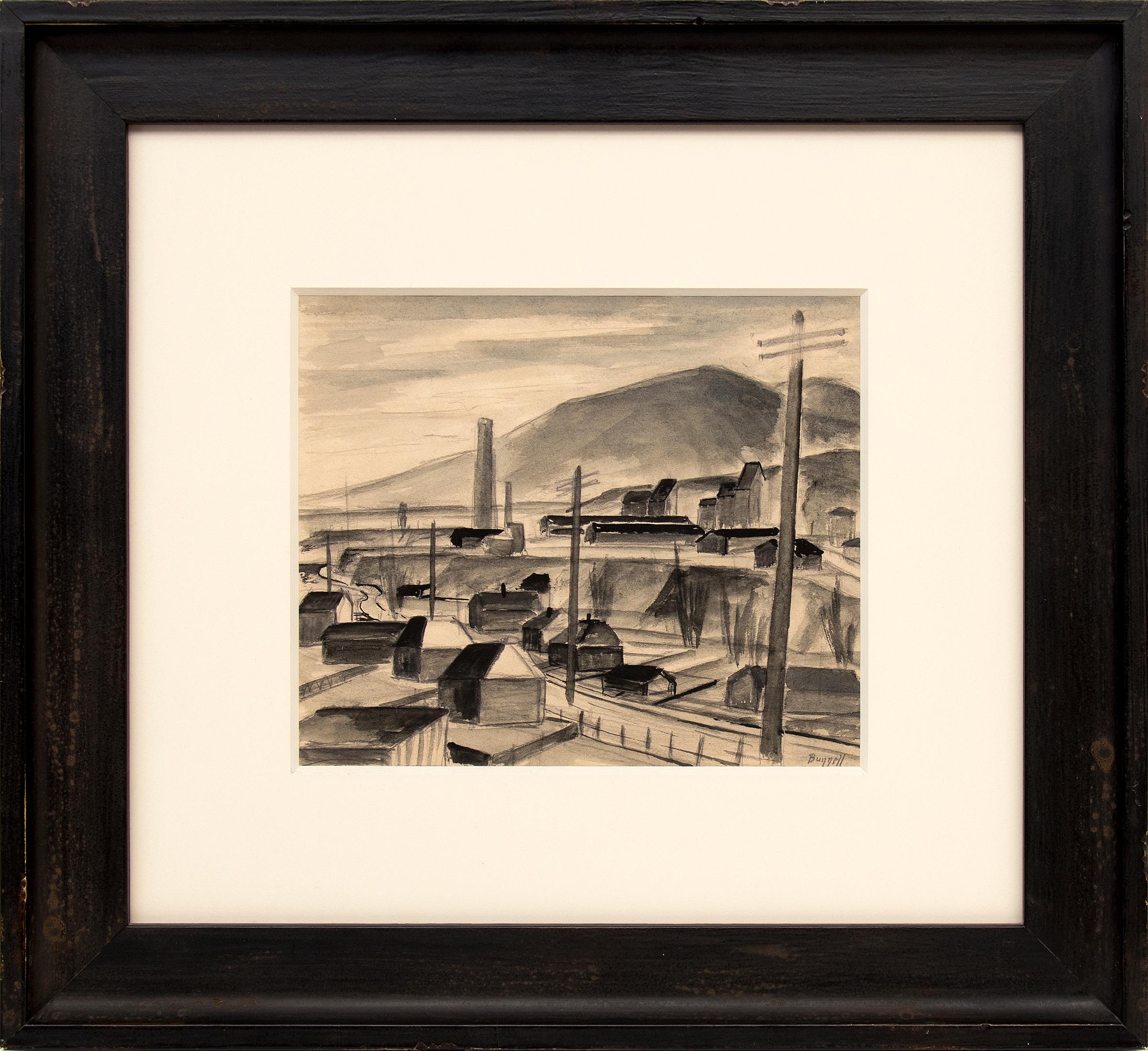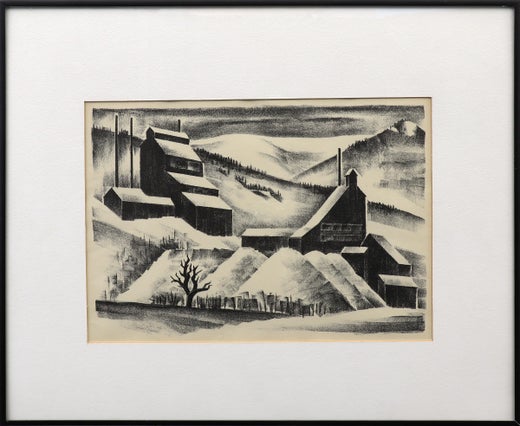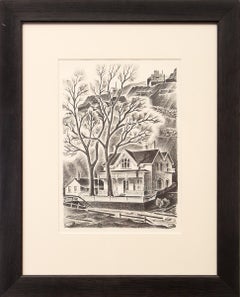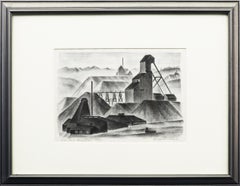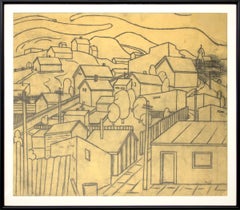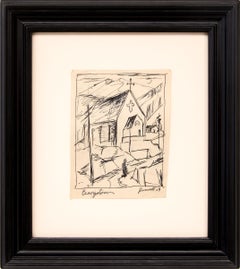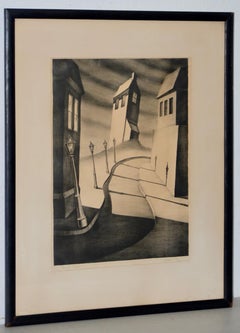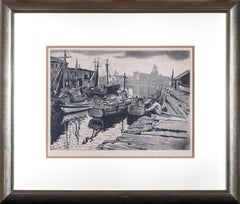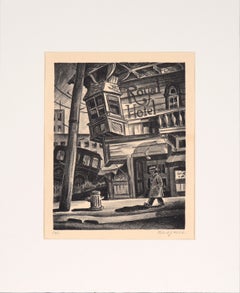Items Similar to WPA-Era Central City, Colorado, 1930s Modernist Lithograph, Cityscape 3/25
Want more images or videos?
Request additional images or videos from the seller
1 of 13
Arnold RönnebeckWPA-Era Central City, Colorado, 1930s Modernist Lithograph, Cityscape 3/251933
1933
$1,350
$2,75050% Off
£1,020.15
£2,078.0850% Off
€1,178.02
€2,399.6850% Off
CA$1,886.42
CA$3,842.7150% Off
A$2,093.14
A$4,263.8150% Off
CHF 1,096.43
CHF 2,233.4850% Off
MX$25,667.56
MX$52,285.7650% Off
NOK 13,946.26
NOK 28,409.0450% Off
SEK 13,164.67
SEK 26,816.9250% Off
DKK 8,785.26
DKK 17,895.9050% Off
Shipping
Retrieving quote...The 1stDibs Promise:
Authenticity Guarantee,
Money-Back Guarantee,
24-Hour Cancellation
About the Item
This 1933 lithograph, Central City, Colorado 3/25, by Arnold Rönnebeck, captures the architectural essence of a historic mining town during the Great Depression. Rendered in black and white, the piece showcases intersecting lines and planes, emblematic of Rönnebeck's "living cubism" style, reflecting the WPA-era's focus on American realism. The image size is 14¾ x 10 inches, presented in a custom black frame measuring 24½ x 19⅝ x ⅝ inches.
Provenance: Private collection, Denver
About the Artist:
Born in 1885, Arnold Rönnebeck was a pivotal figure in American modernism. After studying in Berlin and Paris, he settled in Denver in 1926. Rönnebeck's work, including this lithograph, reflects the WPA-era's commitment to depicting American life with precision and modernist aesthetics. His contributions to the Denver Art Museum and his involvement with the Central City Opera in 1933 underscore his deep connection to Colorado's cultural landscape.
- Creator:Arnold Rönnebeck (1885 - 1947)
- Creation Year:1933
- Dimensions:Height: 24.5 in (62.23 cm)Width: 19.5 in (49.53 cm)Depth: 0.5 in (1.27 cm)
- Medium:
- Movement & Style:
- Period:
- Framing:Frame IncludedFraming Options Available
- Condition:
- Gallery Location:Denver, CO
- Reference Number:Seller: 258311stDibs: LU27310303532
Arnold Rönnebeck
Modernist sculptor, lithographer and museum administrator, Rönnebeck was a noted member of European and American avant-garde circles in the early twentieth century before settling in Denver, Colorado, in 1926. After studying architecture at the Royal Art School in Berlin for two years beginning in 1905, he moved to Paris in 1908 to study sculpture with Aristide Maillol and Émile-Antoine Bourdelle. While there he met and befriended American modernist painter, Marsden Hartley, of whom he sculpted a bronze head that was exhibited at the Salon d’Automne in Paris in 1912 and the following year at Hartley’s solo show of paintings at Alfred Stieglitz’s Gallery 291 in New York. After World War I Rönnebeck traveled in Italy with German writer, Max Sidow, and German poet, Theodor Daubler, doing a series of drawings of Positano and the Amalfi Coast that formed the basis for his lithographs on the subject. The death of his finacée, the young American opera singer Alice Miriam in 1922 and his own family’s increasing financial problems in post-World War I Germany led him to immigrate to the United States in 1923. After living briefly with Miriam’s family in Washington, DC, he moved to New York where he became part of the avant-garde circle around Alfred Stieglitz. In the summer of 1925, as the guest of Mabel Dodge Luhan, Rönnebeck first saw Taos, New Mexico, which Marsden Hartley had encouraged him to visit. It was there that he met his future wife, Louise Emerson, an easel painter and muralist. A year later they were married in New York before relocating to Denver. He served as director of the Denver Art Museum from 1926 to 1930 where he invited Marsden Hartley to lecture on Cézanne’s art in 1928. Rönnebeck fostered the development of the museum’s collection of American Indian art and the curation of modernist art exhibitions. In addition to his work at the museum, he was professor of sculpture at the University of Denver’s College of Fine and Applied Arts from 1929 to 1935, and wrote a weekly art column in the Rocky Mountain News. In Colorado, the subject matter of his lithographs became the state’s landscape and its mining towns, as well as Native Americans from the pueblos in neighboring New Mexico. By the early 1930s Colorado’s old mining towns became a popular genre for artists because they were easily accessible, and their architectural components provided a welcome break from the nineteenth-century panoramic landscape tradition and the overwrought cowboy-and-Indian subject matter of the previous generation. As an amateur actor and music enthusiast, Rönnebeck had an additional connection with Central City. In June 1947, some five months before his death, the Denver Art Museum organized a solo exhibition of his sculptures, watercolors and prints. © copyright Stan Cuba for David Cook Galleries
About the Seller
5.0
Gold Seller
Premium sellers maintaining a 4.3+ rating and 24-hour response times
Established in 1979
1stDibs seller since 2013
290 sales on 1stDibs
Typical response time: 13 hours
- ShippingRetrieving quote...Shipping from: Denver, CO
- Return Policy
Authenticity Guarantee
In the unlikely event there’s an issue with an item’s authenticity, contact us within 1 year for a full refund. DetailsMoney-Back Guarantee
If your item is not as described, is damaged in transit, or does not arrive, contact us within 7 days for a full refund. Details24-Hour Cancellation
You have a 24-hour grace period in which to reconsider your purchase, with no questions asked.Vetted Professional Sellers
Our world-class sellers must adhere to strict standards for service and quality, maintaining the integrity of our listings.Price-Match Guarantee
If you find that a seller listed the same item for a lower price elsewhere, we’ll match it.Trusted Global Delivery
Our best-in-class carrier network provides specialized shipping options worldwide, including custom delivery.More From This Seller
View AllArnold Ronnebeck Lithograph of Gregory Point, Colorado, 1930s Modernist Print
By Arnold Rönnebeck
Located in Denver, CO
This original 1930s lithograph by renowned modernist artist Arnold Ronnebeck (1885–1947) captures a historic home at Gregory Point, near Central City, Colorado. Part of a limited edi...
Category
1930s American Modern Landscape Prints
Materials
Lithograph, Paper
Silver Mine, Russell Gulch, CO (12/25) 1930s American Modern Lithograph Print
By Arnold Rönnebeck
Located in Denver, CO
"Silver Mine, Russell Gulch (12/25)" is a captivating black and white lithograph by American artist Arnold Ronnebeck. The piece features a mining scene in Russell Gulch, Colorado, wi...
Category
1930s American Modern Figurative Prints
Materials
Lithograph
1930s WPA Era Graphite Drawing, American Modern City Scene of Houses on Hill, CO
By Charles Ragland Bunnell
Located in Denver, CO
Graphite on paper drawing by Charles Ragland Bunnell (1897–1968), circa 1935, featuring a modernist cityscape of houses on a hill in Colorado. This artwork, created during the 1930s ...
Category
1930s American Modern Landscape Drawings and Watercolors
Materials
Graphite
Georgetown, Colorado, 1938 WPA Era Ink Drawing of Rocky Mountain Landscape
By Charles Ragland Bunnell
Located in Denver, CO
This vintage 1938 ink drawing by Charles Bunnell (1897–1968) captures a stunning scene of a church nestled in the majestic Rocky Mountains of Georgetown, Colorado. Executed in bold black ink on creamy white paper, the piece is signed and dated by the artist in the lower right and titled in the lower left. The image size is 7 ¾ x 5 ¾ inches, and it is framed with archival materials, with outer dimensions measuring 16 ¼ x 14 ½ x 1 ¼ inches.
Condition:
The drawing is in good vintage condition, with no notable flaws. For a detailed condition report, please contact us directly.
Provenance:
This artwork comes from the estate of Charles Ragland Bunnell, ensuring its authenticity.
About Charles Bunnell:
Charles Bunnell was a prominent American artist whose career spanned multiple styles and influences. Born in Kansas City, Missouri, he moved to Colorado Springs around 1915, where he developed a love for art. After serving in World War I, Bunnell studied at the Broadmoor Art Academy (later renamed the Colorado Springs Fine Arts Center), where he met his wife, Laura Palmer...
Category
1930s American Modern Landscape Drawings and Watercolors
Materials
Ink
Golden Cycle Mill Colorado WPA Mining Watercolor, 1940s Grayscale Artwork
By Charles Ragland Bunnell
Located in Denver, CO
Original 1940s grayscale watercolor painting by American artist Charles Ragland Bunnell, capturing a semi-abstracted view of the Golden Cycle Mill in Colorado Springs, Colorado. Painted in subtle shades of black and gray, this unique WPA-era landscape combines industrial subject matter with expressive, modernist style. A striking piece of American regionalist art from the mid-20th century.
The work is presented in a custom black frame.
Framed dimensions: 18" H x 19 ½" W x 1 ⅜" D
Sight size: 8 ⅛" H x 9 ⅝" W
The Golden Cycle Mining and Reduction Company, depicted in this piece, was a major part of Colorado's mining boom in the early 20th century. Located in Colorado City (now part of Old Colorado City), the mill played a significant role in the region’s gold production and industrial development.
About the Artist: Charles Ragland Bunnell (1897–1968)
Charles Bunnell was a pivotal figure in Colorado’s 20th-century art scene. He worked across multiple styles—from representational landscapes to fully abstract compositions—and was one of the few artists in Colorado to successfully embrace the evolving trends of Modernism, Surrealism, and Abstraction after WWII.
Bunnell studied under notable artists at the Broadmoor Art Academy, including Ernest Lawson and Birger Sandzén. His early works, including regional landscapes and mining scenes like this one, showcase a mix of American Scene painting and semi-abstract structure. He later became known for his bold experimentation with color, form, and geometry, producing both expressive oils and ink-watercolor series such as Black and Blue.
He participated in multiple New Deal art...
Category
1940s American Modern Landscape Paintings
Materials
Watercolor
Mine Near Continental Divide – 1930s Winter Landscape of Colorado Mountains
By Arnold Rönnebeck
Located in Denver, CO
This rare 1933 lithograph by renowned modernist artist Arnold Rönnebeck captures a dramatic black-and-white winter scene of a Colorado mountain mine, blanketed in snow. The bold cont...
Category
1930s American Modern Landscape Prints
Materials
Lithograph
You May Also Like
Alfred Gray "Silent Street" Signed Lithograph c.1930s
Located in San Francisco, CA
Alfred Gray "Silent Street" Signed Lithograph c.1930s
Rare lithograph by noted artist Alfred Gray.
A surreal street bathed in shadow and light.
Dimensions 15" x 21". The original ...
Category
Early 20th Century Art Deco Landscape Prints
Materials
Lithograph
New York City, The El at Chatham Square - Original lithograph , Handsigned / 100
By Adriaan Lubbers
Located in Paris, IDF
Adriaan Lubbers
New York City, The El at Chatham Square, 1930
Original lithograph
Handsigned in pencil
Numbered / 100
On Rives vellum 28 x 22.5 cm (c. 11 x 9 in)
Very good condition
Category
1930s American Modern Landscape Prints
Materials
Lithograph
Black and White Etching Travel 1930's Realism Water Industrial Outdoors Signed
By Joseph Margulies
Located in Milwaukee, WI
"Fishing Boats Gloucester" is a soft ground etching created by Joseph Margulies. The artist signed this piece in the lower right margin with graphite. This piece depicts several fish...
Category
1930s American Realist Landscape Prints
Materials
Ink, Etching, Aquatint
Royal Hotel - New Orleans 1920s Depression Art Lithograph in Ink on Paper
Located in Soquel, CA
Royal Hotel - New Orleans 1920s Depression Art Lithograph in Ink on Paper
Dramatic street scene with a man wearing a trench coat and hat by Robert J We...
Category
Late 20th Century American Modern Landscape Prints
Materials
Paper, Lithograph
Chicago Scene Modernist Architectural Lithograph, Nevada Artist
Located in Surfside, FL
Jim McCormick was born in Chicago in 1936. He attended the University of Tulsa where he received a bachelor’s degree in art in 1958, then a M.A. in paint...
Category
1980s American Modern Abstract Prints
Materials
Lithograph
Cincinnati Ohio cityscape drawing WPA era
Located in Wilton Manors, FL
Beautiful original drawing by American artist, Albert Sway (b.1913). Cincinnati Cityscape, ca. 1935. Ink on paper measures 9.5 x 12 inches. Signed lower right. Good condition with no...
Category
1930s American Realist Landscape Drawings and Watercolors
Materials
Paper, Ink
More Ways To Browse
Depression Era Lithographs
Raymond Price
Warhol Campbell Soup Print
Warhol Hand Flowers
Wooden Vertical Sculpture
19th Century Judaica
Albrecht Durer Etchings
Georges Braque Poster
Green Sex
Henri Matisse Original Hand Signed
Keith Haring 1998
T Powers
Weimar Republic
Campbell Soup Vintage
Keith Haring Pop Shop Poster
Le Mans Car
Metropolitan Opera Poster
Murakami Screen Print
